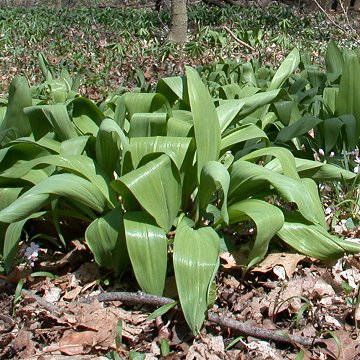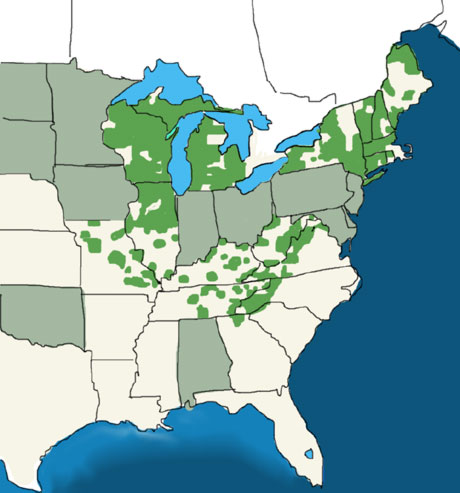

Allium tricoccum - (image 1 of 9)
Taxonomy
Family: Liliaceae
Allium tricoccum Ait.
Allium burdickii Hanes. after Dr. J.H. Burdick who first described the differences between these two species. At the time they were regarded as different races.
Habitat
Mesic woods. Fertile soil derived from calcareous parent material
Associates
Allium tricoccum - Acer saccharum, Dentaria laciniata, Dicentra canadensis, Dicentra, cucullaria, Erythornium americanum, Fagus grandifolia, Galium aparine, Geranium maculatum, Hydrophyllum virginianum, Podophyllum peltatum, Sanguinaria canadensis, Smilacina racemosa, Trillium grandiflorum, and Trillium recurvatum. (Swink 93).
Allium burdickii - Arisaema triphyllum, Claytonia virginica, Erythronium albidum, Fraxinus americana, Galium aparine, Geranium maculatum, Geum canadense, Hepatica acutilobum, Osmorhiza claytonii, Ostrya virginiana, Polygonatum canaliculatum, Polygonum virginianum, Prunus serotina, Prunus virginiana, Quercus alba, Quercus rubra, Ranunculus abortivus, Smilacina racemosa, Tilia americana, Trillium recurvatum, and Ulmus americana. (Swink 94)
Tree species: Acer saccharum and Fagus grandifolia. Tsuga canadensis and Betula lutea. Fraxinus americana and Ulmus americana.
Distribution
New Brunswick, along the northern edge of St. Lawrence River Valley, and into northern Minnesota. Southward in parts of Missouri, Kentucky, and the higher elevations of Tennessee, the Carolinas and Georgia. Novia Scotia, Quebec and New England. Range similar to that of Acer Saccharum.

Morphology
Flowers: Umbel on a scape. 10 - 68 flowers per umbel. Green to White. Mean 23-31. May be tinted with red or purple in
A. tricoccum - scape length typically 20-30cm in length, perhaps slightly longer in A. burdickii. Bloom early June to early July.
A. burdickii.- scaped range from 7.2 to 37.2 cm in length. May bloom a little
later than A. tricoccum.
Leaves: Basal, smooth, straplike. 10-30cm long. Absent at
flowering time.
A. tricoccum: Petiole red, bulbs shallowly buried. Leaves average more than 2.5 cm wide
A. burdickii: Petiole green, short. Bulbs deeply buried. Leaves average less
than 2.5 cm wide.
Fruit: Smooth, round, glossy black. Roll easily and "bounce
beautifully on a concrete sidewalk" (Swink 94). Seeds of A. burdickii maturing
in July
Habit: Attractive foliage.
Young plants typically have one leaf that is linear and grasslike. As the plants mature, the width of the leaves widens and the number of leaves increases up to three. Mature plants normally have three leaves and sometimes two. In a single season, the first leaf to grow is usually the broadest. The second leaf is more narrow and the third is laceolate and situated between the two.
Bulbs ovoid, clustered, 1-2 feet high, seated on a short rootstock, their coats fibrous-reticulated. Leaves oblong-lanceolate or elliptic, appearing early in the spring, but withering before flowering time. Scape 4 to 15 inches tall. Bracts of the umbel usually 2 acuminate, deciduous. Umbel erect, pedicels becoming rigid. Flowers white, perianth segments oblong, obtuse 2-3 inches long. Filiments laceolate-subulate, ovule 1 in each cavity. Capsule deeply 3-lobed, about 3 inches broad, 1.5 to 2 inches high, it's valves not crested. Seeds globose, black smooth. (Britton 497)
Notes
Called ramps in the Southern Appalachians, wild leek is a popular wild food. Plants from the south are said to be spicier than their northern counterparts. All parts of the plant are edible and taste like a mild onion. In the Great Smokey Mountains they are gathered each spring for the annual "Ramp Festival". Indians treated insect stings with juice from the crushed bulbs. (Niering 595)
I have retyped the original letters from J. H. Burdick that were first published in Walker's thesis. Some formatting added to make it easier to read.
Letter from Dr. J.H. Burdick
Utica, Wis. 5-15-84
Prof. Asa Gray, -
Dear Sir:
Six or seven years ago I called your attention to a form of Allium tricoccum with purple scape and petioles. I also sent you some live specimens but don't know whether they have been propagated or not. If you have lost sight of the matter I would like to call it again to your notice, for I feel sure it is a distinct variety at least. I have found it only in limited numbers in but two localities.
The common form of A. tricoccum is extremely common hereabouts. If the purple form is as rare in other parts as here, it has probably escaped the notice of botantists. The more striking characteristics are as follows:
Leaves bright freen and shining both sides as if varnished.
Petioles distinct for an inch or more above the ground, deep purple
Scape purple like the petioles
The leaves are always in pairs, never in threes as often in the common form
Grows in the clayey bank of a lake or stream
Sereno Watson suggests that the difference between the two forms may be due to the difference of the soil and situation in which they grow. This can hardly be, for I have found the two forms growing side by side where the distinction between them was as sharp and apparent as between an aspen and a cottonwood. I hope to secure live plants and seeds this year and so propagate the plant if I cannot find any new localities. If you should wish I would be glad to send you specimens.
Yours truly,
J.H. Burdick
Office of J.H. Burdick, M.D.
Utica, Wis, April 29 - 1885
Prof. Sereno Watson, Cambridge, -
Dear Sir:
Perhaps you will remember that I sent some fresh specimens of an Allium to Prof. Gray some years since, which, in his absence, you passed upon. I was under the impression at the time that they were a distinct variety or A. tricoccum, but you called them a sport or accidental variation of form, I believe. I have since observed the plant closely since and I confidently believe it to be a variety quite distinct. I have never found it in more than two or three localities and always in clay banks.
In one place A. tricoccum grows close by in the more alluvial soil - the two forms even overlapping. Still the distinction is always very plain. The new form has bright, shining leaves with purple footstalk always very plain. The typical form has glaucous leaves with white footstalks. In the new form the leaves are twin, in the other frequently three. Again, in the new form the leaves have very distinct footstalks, while in the other the leaves run more into the ground. The scape in the new form is purple like the petiole.
If you care to investigate I shall be pleased to send you fresh specimens of the two forms that you may compare them. Prof. Gray requested living specimens for the folders which I sent, but he has never reported on them. I wrote to him about a year ago concerning the plant but received no reply. I am so certain the plant is distinct that in my collection I have labeled it Allium tricoccum var. purpurrum.
Very truly yours,
J.H. Burdick
Works Cited
Britton L.N. & A. Brown. 1913. An Illustrated Flora of the United States, Canada and British Possessions.
Volumes 1. Hafner Press, New York.
Niering, W. A. 1979. The Audubon Society Field Guide to North American Wildflowers: Eastern Region.
Knopf/Random House, New York.
Swink, F. and G. Wilhelm. 1994. Plants of the Chicago Region.
Indiana Academy of Science. The Morton Arboretum. Lisle, Illinois.
Walker, Luise E. 1961. A Study of the Variation in Allium Tricoccum
Masters Thesis SUNY ESF Syracuse N.Y.
|
© Michael Hough 2004 |